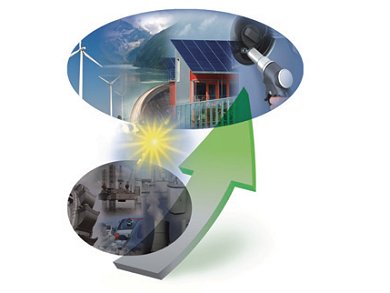The term energy transition refers to the shift of several countries to more sustainable economies by adopting renewable energy sources, and improving energy efficiency. In 2011, renewables supplied almost 20 % of global electricity [1]. The G8 climate change goal for 2050 is to reduce CO2 emissions by 80 %.
Strategies to developing more sustainable energy systems vary from country to country and region to region, depending on geological and political conditions. Nevertheless, worldwide trends, such as an increase in solar power (60 % in 2011) and in wind power (30 % in 2011), can be seen.
The book Transition to Renewable Energy Systems edited by Detlef Stolten and Viktor Scherer [2], gives an excellent summary of the field. It focuses exclusively on technologies that have the potential to leave the research phase by 2030. Only these technologies may have the potential to be in place by 2050, as a further ten years are usually required for industrial development and another ten years for market penetration. International experts look at the potential of different technological options for different countries to achieve a sustainable energy supply.
Germany
The German government, for example, decided to change the German energy system to a more sustainable one and make Germany one of the most energy-efficient economies in the world. Targets of the Energiewende (energy transition) include:
- reducing greenhouse emissions by 80–95 % by 2020 compared with 1990,
- ensuring that energy from renewable sources account for 60 % of gross final energy consumption and 80 % of gross electricity consumption, and,
- the most ambitious target: cutting the primary energy consumption by 50 % compared with 2008.
For German industry this means both, tremendous opportunities and significant challenges. The challenges mainly comprise matters of costs for development and thus international competition. The Energiewende is not an isolated process, for example, as the shale gas revolution in the USA leads to a dramatic price drop for gas and electricity, Germany and Europe have to compete against this.
Another crucial aspect is expanding the electricity grid to adjust the fluctuations of renewable energies and to integrate decentralized energy sources. This has been initiated, but is currently behind schedule.
Japan
Hirohisa Uchida, Department of Nuclear Engineering, Kanagawa, Japan, discusses the influence of the Fukushima Dai-Ichi nuclear power plant (FDNPP) accident on the people of Japan and on Japan’s energy policy [2]. He says that many people are still not back in their homes due to radioactive contamination. By May 2012 all 54 reactors had been totally shut down; since July only two reactors have been in operation.
According to a public opinion poll by the government, 70 % of the Japanese people want to stop nuclear power, and would prefer an energy transition to safe and clean energy sources, such as renewable energy. A renewable energy policy, hydrogen technology, and the reduction of nuclear dependency was proposed by the former government. However, Japan’s economic and industrial communities insist on the further use of nuclear power to avoid unstable power supplies and increases in electricity charges. In February 2013 a new government was elected. It is still unclear what their plans are.
Scotland
In the Electricity Generation Policy Statement (EGPS) the Scottish Government sets out their plans to meet the target of delivering at least the equivalent of 100 % of the gross electricity consumption from renewables by 2020. Their strategy for renewable electricity generation includes a significant increase in on and offshore wind, wave, tidal and hydro power, and small scale renewable generation, as well as very clear cost-reduction strategies.
Scotland, as well as Ireland, is one of the windiest countries in the EU and has the largest offshore energy resources with 25 % of the EU’s offshore wind power, 25 % of the EU’s tidal power, and 10 % of the EU’s wave power [2].
Colin Imrie, Scottish Government, Energy and Climate Change Director, Glasgow, UK, explains that the Scottish government’s vision includes international cooperation across the North Sea to promote the development of offshore electricity grid connections. They are also cooperating with Scottish gas companies to benefit from their rich experience of harsh weather conditions.
Although it is not very popular in the rest of Europe, by 2018, the UK plans to run two Carbon Capture and Storage (CCS) plants; one of them in Scotland.
Fracking is discussed controversially worldwide. However, the USA is seeing an enormous economic boom because of it. Thus, the availability of shale gas makes solar energy less attractive in the USA, whereas Saudi Arabia is becoming increasingly interested in this technology.
References
[1] Industry Roundup: Renewable Energies: Wind, Solar, Biomass, ChemViews Mag. 2012. DOI: 10.1002/chemv.201200005
[2] Transition to Renewable Energy Systems (Eds: D. Stolten, V. Scherer), Wiley-VCH, Weinheim, Germany, 2013.
- Which major technologies are transforming our energy systems to renewable energy
discussed in depth at the 3rd International Conference on Energy Process Engineering (3rd ICEPE): Transition to Renewable Energy Systems, held in June 2013.
The conference is directly related to the book and was chaired by the editors of the book.




